Analyzing Accounting Standards: Fair Value, Impairment, and IFRS 13
VerifiedAdded on 2020/10/05
|8
|2257
|152
Report
AI Summary
This report provides a comprehensive overview of accounting standards, with a specific focus on fair value measurement as per IFRS 13 and impairment loss. The report begins with an introduction to accounting standards and their importance in financial reporting, followed by a detailed explanati...
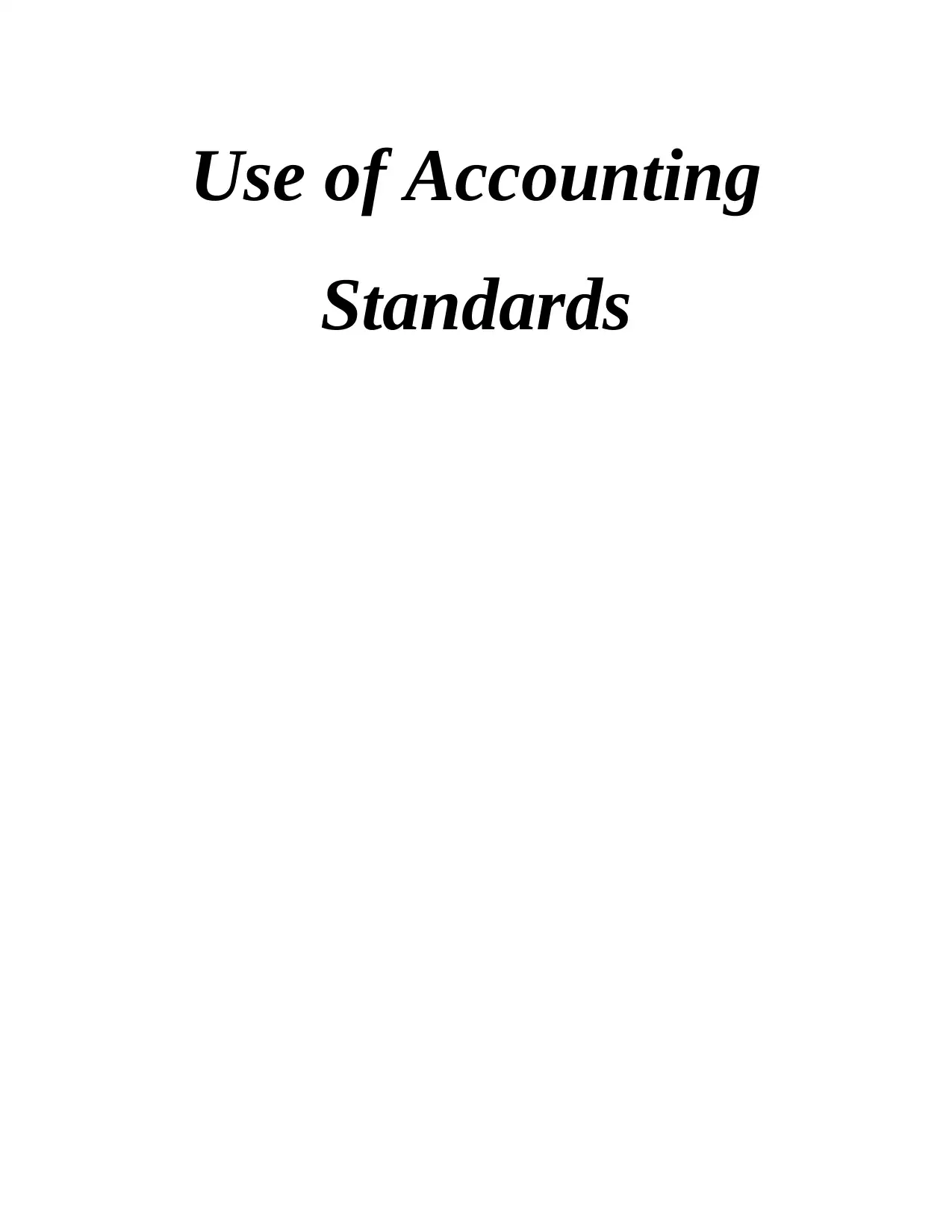
Use of Accounting
Standards
Standards
Paraphrase This Document
Need a fresh take? Get an instant paraphrase of this document with our AI Paraphraser
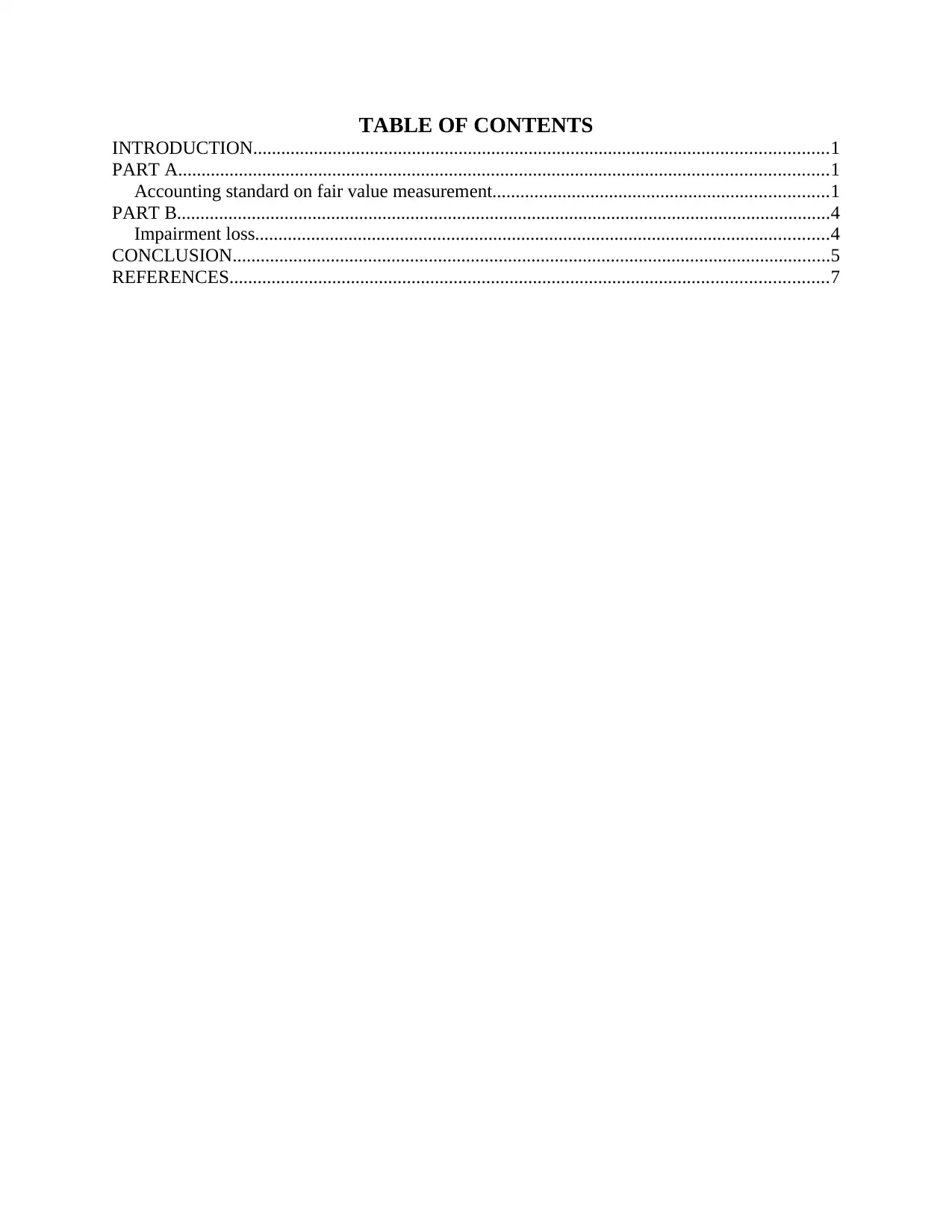
TABLE OF CONTENTS
INTRODUCTION...........................................................................................................................1
PART A...........................................................................................................................................1
Accounting standard on fair value measurement........................................................................1
PART B............................................................................................................................................4
Impairment loss...........................................................................................................................4
CONCLUSION................................................................................................................................5
REFERENCES................................................................................................................................7
INTRODUCTION...........................................................................................................................1
PART A...........................................................................................................................................1
Accounting standard on fair value measurement........................................................................1
PART B............................................................................................................................................4
Impairment loss...........................................................................................................................4
CONCLUSION................................................................................................................................5
REFERENCES................................................................................................................................7
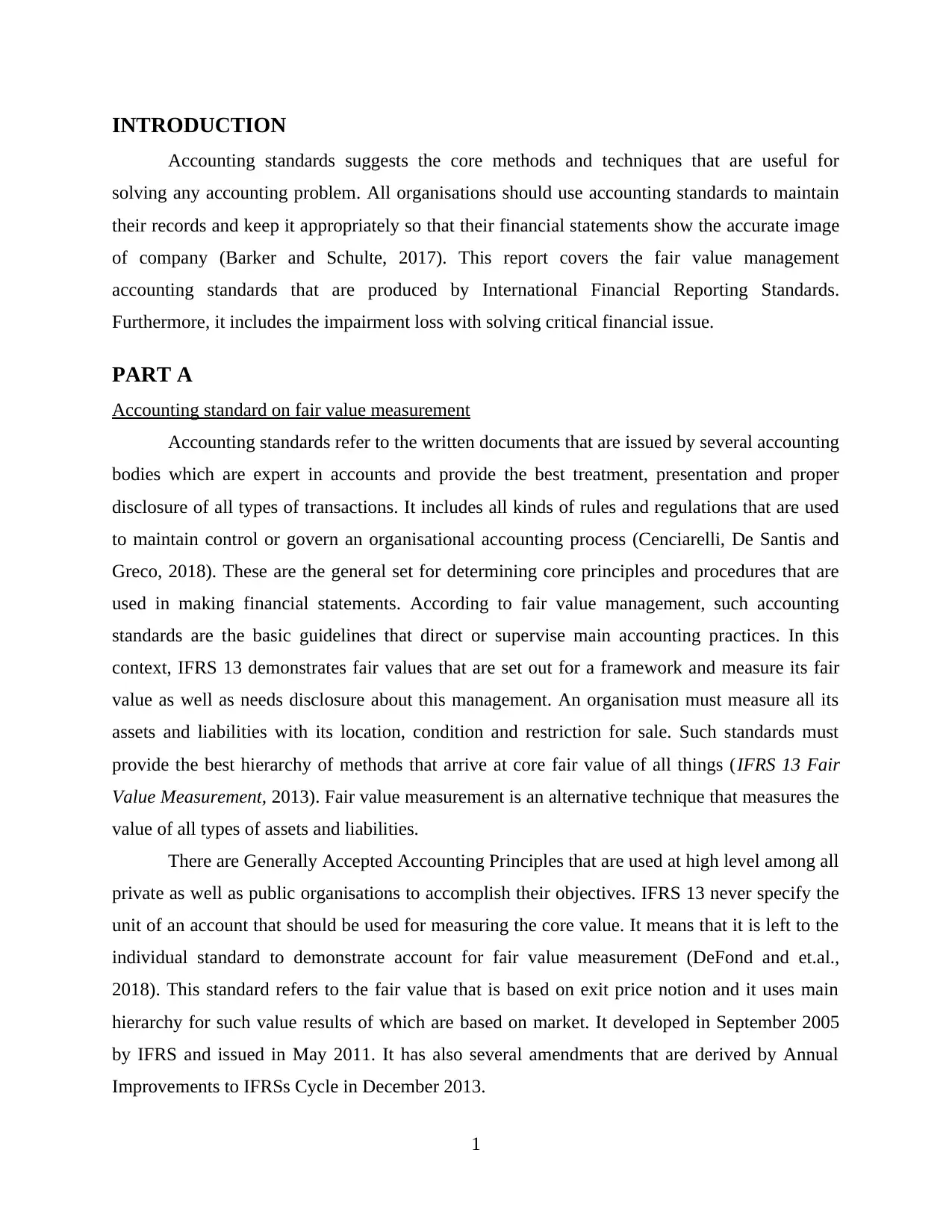
INTRODUCTION
Accounting standards suggests the core methods and techniques that are useful for
solving any accounting problem. All organisations should use accounting standards to maintain
their records and keep it appropriately so that their financial statements show the accurate image
of company (Barker and Schulte, 2017). This report covers the fair value management
accounting standards that are produced by International Financial Reporting Standards.
Furthermore, it includes the impairment loss with solving critical financial issue.
PART A
Accounting standard on fair value measurement
Accounting standards refer to the written documents that are issued by several accounting
bodies which are expert in accounts and provide the best treatment, presentation and proper
disclosure of all types of transactions. It includes all kinds of rules and regulations that are used
to maintain control or govern an organisational accounting process (Cenciarelli, De Santis and
Greco, 2018). These are the general set for determining core principles and procedures that are
used in making financial statements. According to fair value management, such accounting
standards are the basic guidelines that direct or supervise main accounting practices. In this
context, IFRS 13 demonstrates fair values that are set out for a framework and measure its fair
value as well as needs disclosure about this management. An organisation must measure all its
assets and liabilities with its location, condition and restriction for sale. Such standards must
provide the best hierarchy of methods that arrive at core fair value of all things (IFRS 13 Fair
Value Measurement, 2013). Fair value measurement is an alternative technique that measures the
value of all types of assets and liabilities.
There are Generally Accepted Accounting Principles that are used at high level among all
private as well as public organisations to accomplish their objectives. IFRS 13 never specify the
unit of an account that should be used for measuring the core value. It means that it is left to the
individual standard to demonstrate account for fair value measurement (DeFond and et.al.,
2018). This standard refers to the fair value that is based on exit price notion and it uses main
hierarchy for such value results of which are based on market. It developed in September 2005
by IFRS and issued in May 2011. It has also several amendments that are derived by Annual
Improvements to IFRSs Cycle in December 2013.
1
Accounting standards suggests the core methods and techniques that are useful for
solving any accounting problem. All organisations should use accounting standards to maintain
their records and keep it appropriately so that their financial statements show the accurate image
of company (Barker and Schulte, 2017). This report covers the fair value management
accounting standards that are produced by International Financial Reporting Standards.
Furthermore, it includes the impairment loss with solving critical financial issue.
PART A
Accounting standard on fair value measurement
Accounting standards refer to the written documents that are issued by several accounting
bodies which are expert in accounts and provide the best treatment, presentation and proper
disclosure of all types of transactions. It includes all kinds of rules and regulations that are used
to maintain control or govern an organisational accounting process (Cenciarelli, De Santis and
Greco, 2018). These are the general set for determining core principles and procedures that are
used in making financial statements. According to fair value management, such accounting
standards are the basic guidelines that direct or supervise main accounting practices. In this
context, IFRS 13 demonstrates fair values that are set out for a framework and measure its fair
value as well as needs disclosure about this management. An organisation must measure all its
assets and liabilities with its location, condition and restriction for sale. Such standards must
provide the best hierarchy of methods that arrive at core fair value of all things (IFRS 13 Fair
Value Measurement, 2013). Fair value measurement is an alternative technique that measures the
value of all types of assets and liabilities.
There are Generally Accepted Accounting Principles that are used at high level among all
private as well as public organisations to accomplish their objectives. IFRS 13 never specify the
unit of an account that should be used for measuring the core value. It means that it is left to the
individual standard to demonstrate account for fair value measurement (DeFond and et.al.,
2018). This standard refers to the fair value that is based on exit price notion and it uses main
hierarchy for such value results of which are based on market. It developed in September 2005
by IFRS and issued in May 2011. It has also several amendments that are derived by Annual
Improvements to IFRSs Cycle in December 2013.
1
⊘ This is a preview!⊘
Do you want full access?
Subscribe today to unlock all pages.

Trusted by 1+ million students worldwide
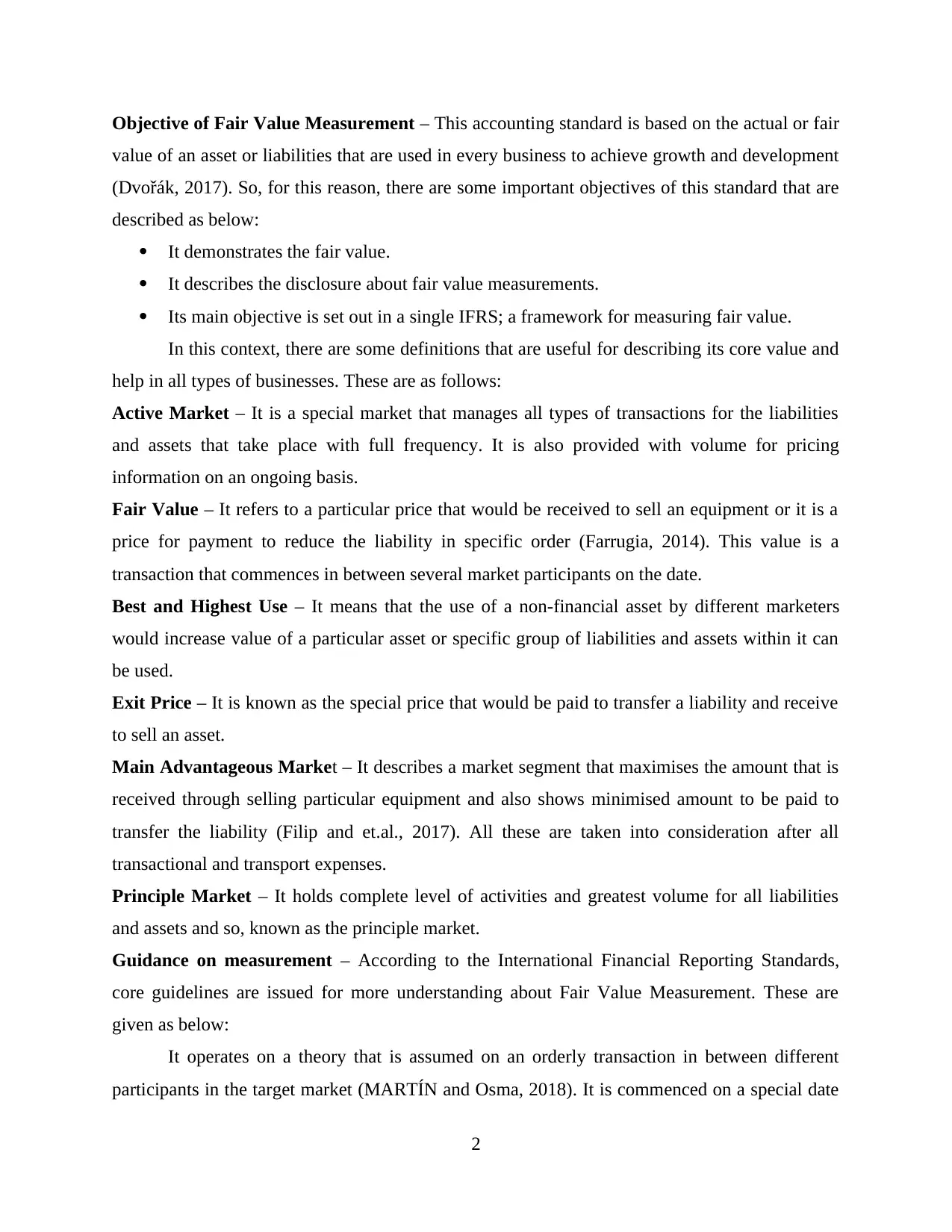
Objective of Fair Value Measurement – This accounting standard is based on the actual or fair
value of an asset or liabilities that are used in every business to achieve growth and development
(Dvořák, 2017). So, for this reason, there are some important objectives of this standard that are
described as below:
It demonstrates the fair value.
It describes the disclosure about fair value measurements.
Its main objective is set out in a single IFRS; a framework for measuring fair value.
In this context, there are some definitions that are useful for describing its core value and
help in all types of businesses. These are as follows:
Active Market – It is a special market that manages all types of transactions for the liabilities
and assets that take place with full frequency. It is also provided with volume for pricing
information on an ongoing basis.
Fair Value – It refers to a particular price that would be received to sell an equipment or it is a
price for payment to reduce the liability in specific order (Farrugia, 2014). This value is a
transaction that commences in between several market participants on the date.
Best and Highest Use – It means that the use of a non-financial asset by different marketers
would increase value of a particular asset or specific group of liabilities and assets within it can
be used.
Exit Price – It is known as the special price that would be paid to transfer a liability and receive
to sell an asset.
Main Advantageous Market – It describes a market segment that maximises the amount that is
received through selling particular equipment and also shows minimised amount to be paid to
transfer the liability (Filip and et.al., 2017). All these are taken into consideration after all
transactional and transport expenses.
Principle Market – It holds complete level of activities and greatest volume for all liabilities
and assets and so, known as the principle market.
Guidance on measurement – According to the International Financial Reporting Standards,
core guidelines are issued for more understanding about Fair Value Measurement. These are
given as below:
It operates on a theory that is assumed on an orderly transaction in between different
participants in the target market (MARTÍN and Osma, 2018). It is commenced on a special date
2
value of an asset or liabilities that are used in every business to achieve growth and development
(Dvořák, 2017). So, for this reason, there are some important objectives of this standard that are
described as below:
It demonstrates the fair value.
It describes the disclosure about fair value measurements.
Its main objective is set out in a single IFRS; a framework for measuring fair value.
In this context, there are some definitions that are useful for describing its core value and
help in all types of businesses. These are as follows:
Active Market – It is a special market that manages all types of transactions for the liabilities
and assets that take place with full frequency. It is also provided with volume for pricing
information on an ongoing basis.
Fair Value – It refers to a particular price that would be received to sell an equipment or it is a
price for payment to reduce the liability in specific order (Farrugia, 2014). This value is a
transaction that commences in between several market participants on the date.
Best and Highest Use – It means that the use of a non-financial asset by different marketers
would increase value of a particular asset or specific group of liabilities and assets within it can
be used.
Exit Price – It is known as the special price that would be paid to transfer a liability and receive
to sell an asset.
Main Advantageous Market – It describes a market segment that maximises the amount that is
received through selling particular equipment and also shows minimised amount to be paid to
transfer the liability (Filip and et.al., 2017). All these are taken into consideration after all
transactional and transport expenses.
Principle Market – It holds complete level of activities and greatest volume for all liabilities
and assets and so, known as the principle market.
Guidance on measurement – According to the International Financial Reporting Standards,
core guidelines are issued for more understanding about Fair Value Measurement. These are
given as below:
It operates on a theory that is assumed on an orderly transaction in between different
participants in the target market (MARTÍN and Osma, 2018). It is commenced on a special date
2
Paraphrase This Document
Need a fresh take? Get an instant paraphrase of this document with our AI Paraphraser
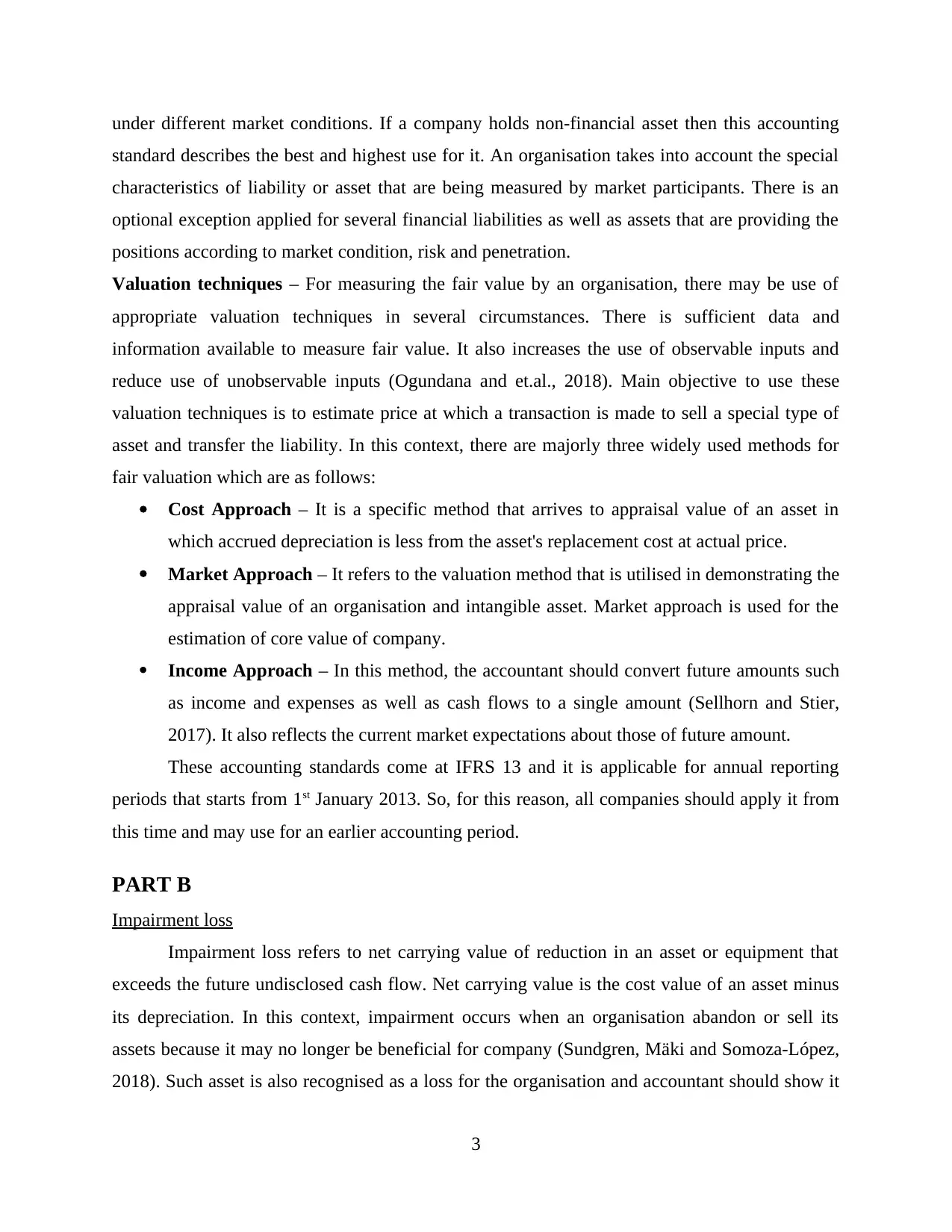
under different market conditions. If a company holds non-financial asset then this accounting
standard describes the best and highest use for it. An organisation takes into account the special
characteristics of liability or asset that are being measured by market participants. There is an
optional exception applied for several financial liabilities as well as assets that are providing the
positions according to market condition, risk and penetration.
Valuation techniques – For measuring the fair value by an organisation, there may be use of
appropriate valuation techniques in several circumstances. There is sufficient data and
information available to measure fair value. It also increases the use of observable inputs and
reduce use of unobservable inputs (Ogundana and et.al., 2018). Main objective to use these
valuation techniques is to estimate price at which a transaction is made to sell a special type of
asset and transfer the liability. In this context, there are majorly three widely used methods for
fair valuation which are as follows:
Cost Approach – It is a specific method that arrives to appraisal value of an asset in
which accrued depreciation is less from the asset's replacement cost at actual price.
Market Approach – It refers to the valuation method that is utilised in demonstrating the
appraisal value of an organisation and intangible asset. Market approach is used for the
estimation of core value of company.
Income Approach – In this method, the accountant should convert future amounts such
as income and expenses as well as cash flows to a single amount (Sellhorn and Stier,
2017). It also reflects the current market expectations about those of future amount.
These accounting standards come at IFRS 13 and it is applicable for annual reporting
periods that starts from 1st January 2013. So, for this reason, all companies should apply it from
this time and may use for an earlier accounting period.
PART B
Impairment loss
Impairment loss refers to net carrying value of reduction in an asset or equipment that
exceeds the future undisclosed cash flow. Net carrying value is the cost value of an asset minus
its depreciation. In this context, impairment occurs when an organisation abandon or sell its
assets because it may no longer be beneficial for company (Sundgren, Mäki and Somoza-López,
2018). Such asset is also recognised as a loss for the organisation and accountant should show it
3
standard describes the best and highest use for it. An organisation takes into account the special
characteristics of liability or asset that are being measured by market participants. There is an
optional exception applied for several financial liabilities as well as assets that are providing the
positions according to market condition, risk and penetration.
Valuation techniques – For measuring the fair value by an organisation, there may be use of
appropriate valuation techniques in several circumstances. There is sufficient data and
information available to measure fair value. It also increases the use of observable inputs and
reduce use of unobservable inputs (Ogundana and et.al., 2018). Main objective to use these
valuation techniques is to estimate price at which a transaction is made to sell a special type of
asset and transfer the liability. In this context, there are majorly three widely used methods for
fair valuation which are as follows:
Cost Approach – It is a specific method that arrives to appraisal value of an asset in
which accrued depreciation is less from the asset's replacement cost at actual price.
Market Approach – It refers to the valuation method that is utilised in demonstrating the
appraisal value of an organisation and intangible asset. Market approach is used for the
estimation of core value of company.
Income Approach – In this method, the accountant should convert future amounts such
as income and expenses as well as cash flows to a single amount (Sellhorn and Stier,
2017). It also reflects the current market expectations about those of future amount.
These accounting standards come at IFRS 13 and it is applicable for annual reporting
periods that starts from 1st January 2013. So, for this reason, all companies should apply it from
this time and may use for an earlier accounting period.
PART B
Impairment loss
Impairment loss refers to net carrying value of reduction in an asset or equipment that
exceeds the future undisclosed cash flow. Net carrying value is the cost value of an asset minus
its depreciation. In this context, impairment occurs when an organisation abandon or sell its
assets because it may no longer be beneficial for company (Sundgren, Mäki and Somoza-López,
2018). Such asset is also recognised as a loss for the organisation and accountant should show it
3
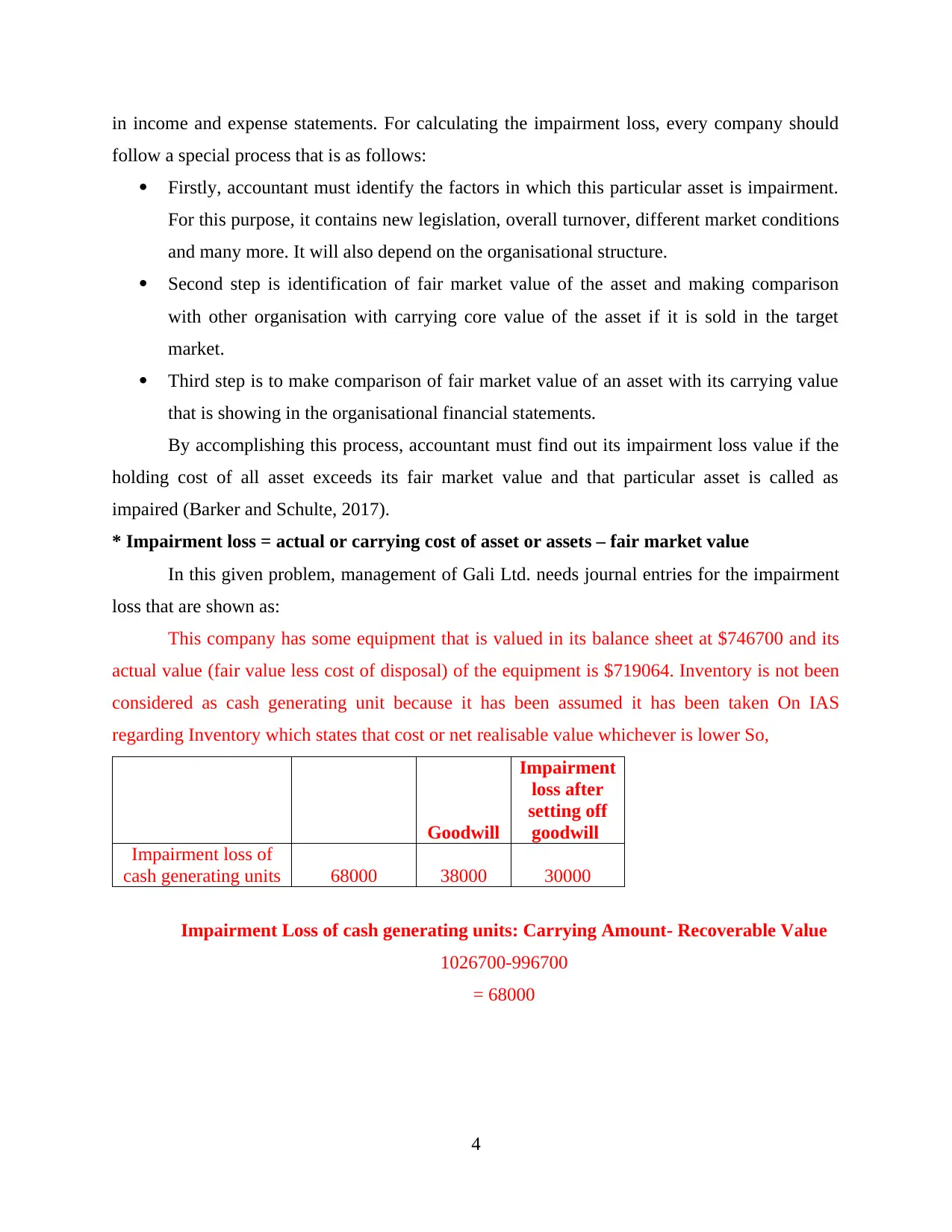
in income and expense statements. For calculating the impairment loss, every company should
follow a special process that is as follows:
Firstly, accountant must identify the factors in which this particular asset is impairment.
For this purpose, it contains new legislation, overall turnover, different market conditions
and many more. It will also depend on the organisational structure.
Second step is identification of fair market value of the asset and making comparison
with other organisation with carrying core value of the asset if it is sold in the target
market.
Third step is to make comparison of fair market value of an asset with its carrying value
that is showing in the organisational financial statements.
By accomplishing this process, accountant must find out its impairment loss value if the
holding cost of all asset exceeds its fair market value and that particular asset is called as
impaired (Barker and Schulte, 2017).
* Impairment loss = actual or carrying cost of asset or assets – fair market value
In this given problem, management of Gali Ltd. needs journal entries for the impairment
loss that are shown as:
This company has some equipment that is valued in its balance sheet at $746700 and its
actual value (fair value less cost of disposal) of the equipment is $719064. Inventory is not been
considered as cash generating unit because it has been assumed it has been taken On IAS
regarding Inventory which states that cost or net realisable value whichever is lower So,
Goodwill
Impairment
loss after
setting off
goodwill
Impairment loss of
cash generating units 68000 38000 30000
Impairment Loss of cash generating units: Carrying Amount- Recoverable Value
1026700-996700
= 68000
4
follow a special process that is as follows:
Firstly, accountant must identify the factors in which this particular asset is impairment.
For this purpose, it contains new legislation, overall turnover, different market conditions
and many more. It will also depend on the organisational structure.
Second step is identification of fair market value of the asset and making comparison
with other organisation with carrying core value of the asset if it is sold in the target
market.
Third step is to make comparison of fair market value of an asset with its carrying value
that is showing in the organisational financial statements.
By accomplishing this process, accountant must find out its impairment loss value if the
holding cost of all asset exceeds its fair market value and that particular asset is called as
impaired (Barker and Schulte, 2017).
* Impairment loss = actual or carrying cost of asset or assets – fair market value
In this given problem, management of Gali Ltd. needs journal entries for the impairment
loss that are shown as:
This company has some equipment that is valued in its balance sheet at $746700 and its
actual value (fair value less cost of disposal) of the equipment is $719064. Inventory is not been
considered as cash generating unit because it has been assumed it has been taken On IAS
regarding Inventory which states that cost or net realisable value whichever is lower So,
Goodwill
Impairment
loss after
setting off
goodwill
Impairment loss of
cash generating units 68000 38000 30000
Impairment Loss of cash generating units: Carrying Amount- Recoverable Value
1026700-996700
= 68000
4
⊘ This is a preview!⊘
Do you want full access?
Subscribe today to unlock all pages.

Trusted by 1+ million students worldwide
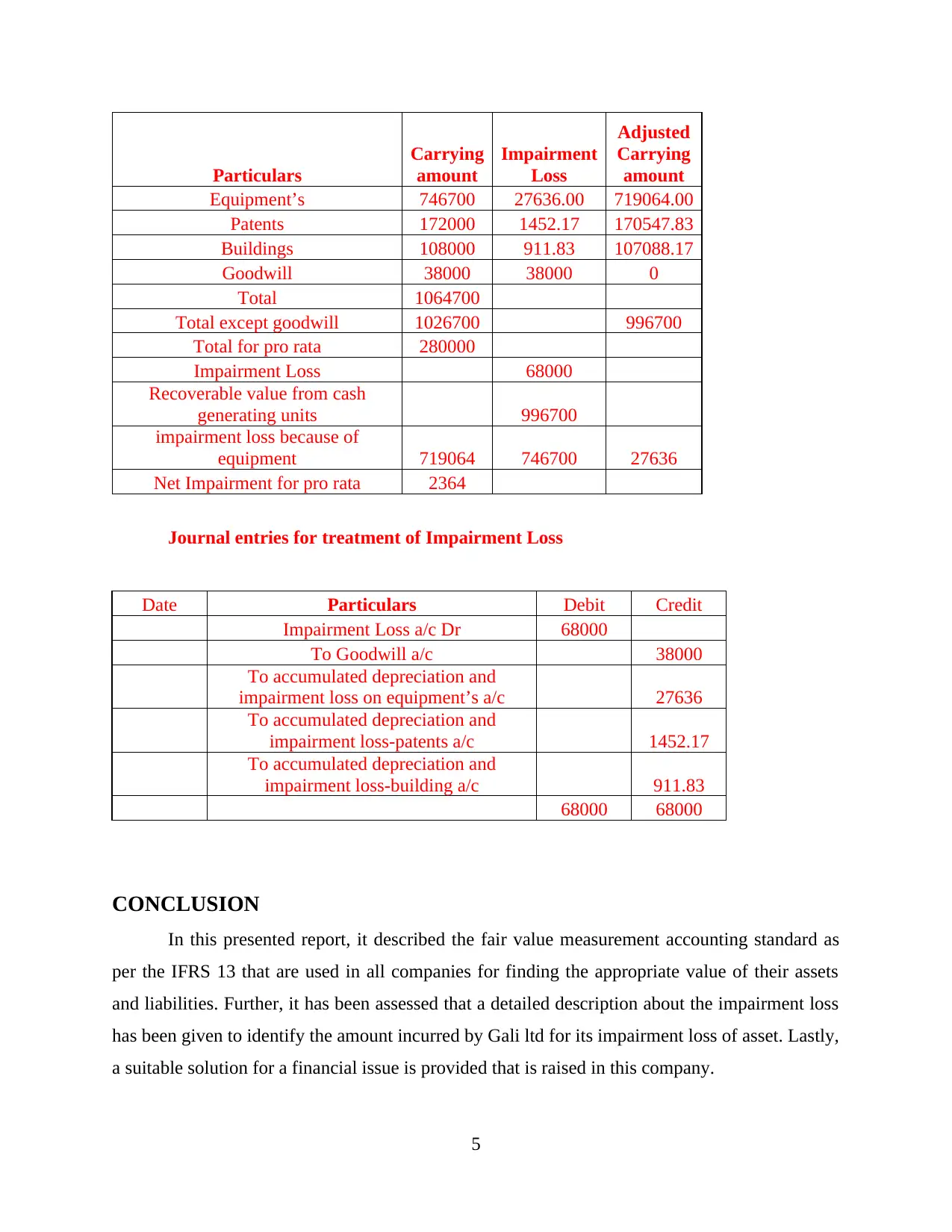
Particulars
Carrying
amount
Impairment
Loss
Adjusted
Carrying
amount
Equipment’s 746700 27636.00 719064.00
Patents 172000 1452.17 170547.83
Buildings 108000 911.83 107088.17
Goodwill 38000 38000 0
Total 1064700
Total except goodwill 1026700 996700
Total for pro rata 280000
Impairment Loss 68000
Recoverable value from cash
generating units 996700
impairment loss because of
equipment 719064 746700 27636
Net Impairment for pro rata 2364
Journal entries for treatment of Impairment Loss
Date Particulars Debit Credit
Impairment Loss a/c Dr 68000
To Goodwill a/c 38000
To accumulated depreciation and
impairment loss on equipment’s a/c 27636
To accumulated depreciation and
impairment loss-patents a/c 1452.17
To accumulated depreciation and
impairment loss-building a/c 911.83
68000 68000
CONCLUSION
In this presented report, it described the fair value measurement accounting standard as
per the IFRS 13 that are used in all companies for finding the appropriate value of their assets
and liabilities. Further, it has been assessed that a detailed description about the impairment loss
has been given to identify the amount incurred by Gali ltd for its impairment loss of asset. Lastly,
a suitable solution for a financial issue is provided that is raised in this company.
5
Carrying
amount
Impairment
Loss
Adjusted
Carrying
amount
Equipment’s 746700 27636.00 719064.00
Patents 172000 1452.17 170547.83
Buildings 108000 911.83 107088.17
Goodwill 38000 38000 0
Total 1064700
Total except goodwill 1026700 996700
Total for pro rata 280000
Impairment Loss 68000
Recoverable value from cash
generating units 996700
impairment loss because of
equipment 719064 746700 27636
Net Impairment for pro rata 2364
Journal entries for treatment of Impairment Loss
Date Particulars Debit Credit
Impairment Loss a/c Dr 68000
To Goodwill a/c 38000
To accumulated depreciation and
impairment loss on equipment’s a/c 27636
To accumulated depreciation and
impairment loss-patents a/c 1452.17
To accumulated depreciation and
impairment loss-building a/c 911.83
68000 68000
CONCLUSION
In this presented report, it described the fair value measurement accounting standard as
per the IFRS 13 that are used in all companies for finding the appropriate value of their assets
and liabilities. Further, it has been assessed that a detailed description about the impairment loss
has been given to identify the amount incurred by Gali ltd for its impairment loss of asset. Lastly,
a suitable solution for a financial issue is provided that is raised in this company.
5
Paraphrase This Document
Need a fresh take? Get an instant paraphrase of this document with our AI Paraphraser
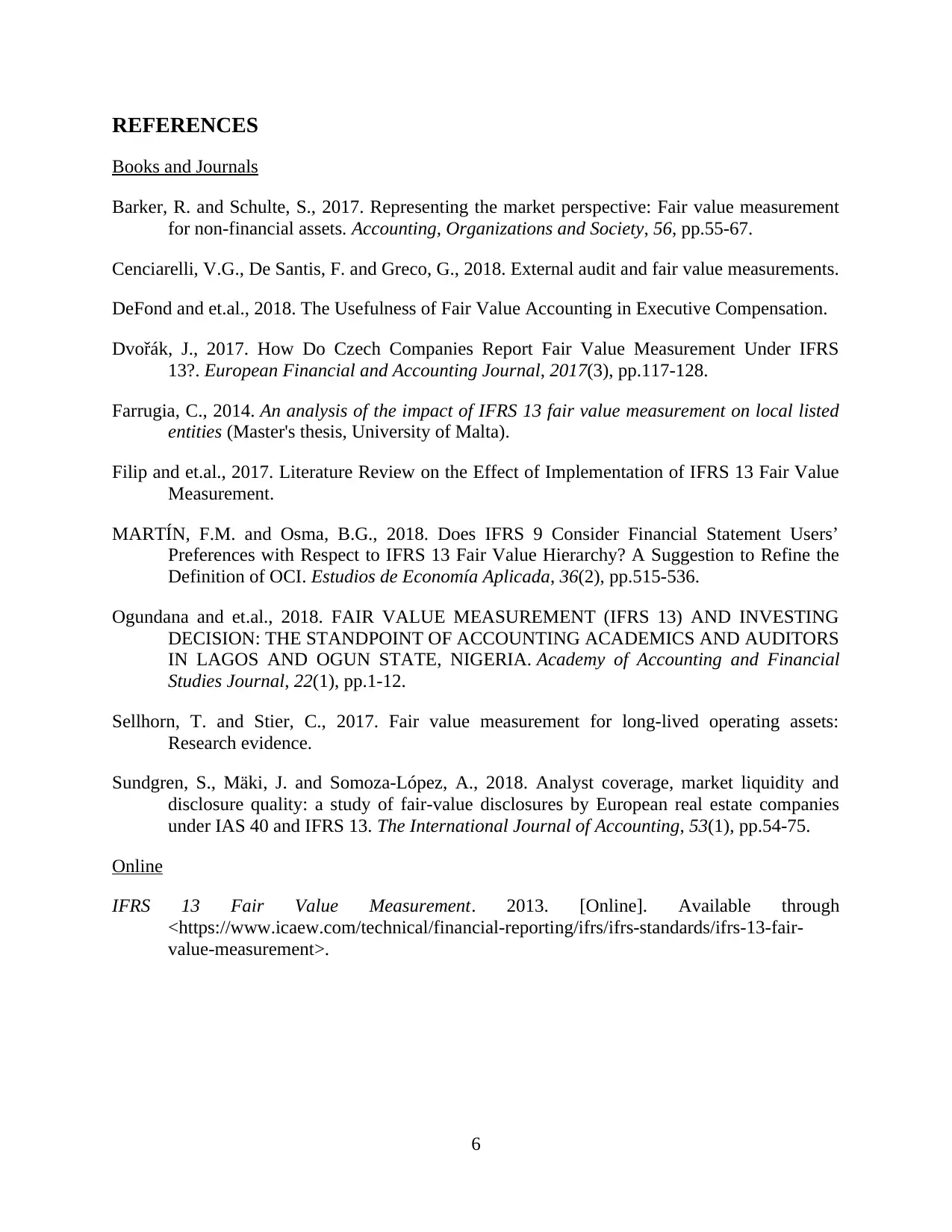
REFERENCES
Books and Journals
Barker, R. and Schulte, S., 2017. Representing the market perspective: Fair value measurement
for non-financial assets. Accounting, Organizations and Society, 56, pp.55-67.
Cenciarelli, V.G., De Santis, F. and Greco, G., 2018. External audit and fair value measurements.
DeFond and et.al., 2018. The Usefulness of Fair Value Accounting in Executive Compensation.
Dvořák, J., 2017. How Do Czech Companies Report Fair Value Measurement Under IFRS
13?. European Financial and Accounting Journal, 2017(3), pp.117-128.
Farrugia, C., 2014. An analysis of the impact of IFRS 13 fair value measurement on local listed
entities (Master's thesis, University of Malta).
Filip and et.al., 2017. Literature Review on the Effect of Implementation of IFRS 13 Fair Value
Measurement.
MARTÍN, F.M. and Osma, B.G., 2018. Does IFRS 9 Consider Financial Statement Users’
Preferences with Respect to IFRS 13 Fair Value Hierarchy? A Suggestion to Refine the
Definition of OCI. Estudios de Economía Aplicada, 36(2), pp.515-536.
Ogundana and et.al., 2018. FAIR VALUE MEASUREMENT (IFRS 13) AND INVESTING
DECISION: THE STANDPOINT OF ACCOUNTING ACADEMICS AND AUDITORS
IN LAGOS AND OGUN STATE, NIGERIA. Academy of Accounting and Financial
Studies Journal, 22(1), pp.1-12.
Sellhorn, T. and Stier, C., 2017. Fair value measurement for long-lived operating assets:
Research evidence.
Sundgren, S., Mäki, J. and Somoza-López, A., 2018. Analyst coverage, market liquidity and
disclosure quality: a study of fair-value disclosures by European real estate companies
under IAS 40 and IFRS 13. The International Journal of Accounting, 53(1), pp.54-75.
Online
IFRS 13 Fair Value Measurement. 2013. [Online]. Available through
<https://www.icaew.com/technical/financial-reporting/ifrs/ifrs-standards/ifrs-13-fair-
value-measurement>.
6
Books and Journals
Barker, R. and Schulte, S., 2017. Representing the market perspective: Fair value measurement
for non-financial assets. Accounting, Organizations and Society, 56, pp.55-67.
Cenciarelli, V.G., De Santis, F. and Greco, G., 2018. External audit and fair value measurements.
DeFond and et.al., 2018. The Usefulness of Fair Value Accounting in Executive Compensation.
Dvořák, J., 2017. How Do Czech Companies Report Fair Value Measurement Under IFRS
13?. European Financial and Accounting Journal, 2017(3), pp.117-128.
Farrugia, C., 2014. An analysis of the impact of IFRS 13 fair value measurement on local listed
entities (Master's thesis, University of Malta).
Filip and et.al., 2017. Literature Review on the Effect of Implementation of IFRS 13 Fair Value
Measurement.
MARTÍN, F.M. and Osma, B.G., 2018. Does IFRS 9 Consider Financial Statement Users’
Preferences with Respect to IFRS 13 Fair Value Hierarchy? A Suggestion to Refine the
Definition of OCI. Estudios de Economía Aplicada, 36(2), pp.515-536.
Ogundana and et.al., 2018. FAIR VALUE MEASUREMENT (IFRS 13) AND INVESTING
DECISION: THE STANDPOINT OF ACCOUNTING ACADEMICS AND AUDITORS
IN LAGOS AND OGUN STATE, NIGERIA. Academy of Accounting and Financial
Studies Journal, 22(1), pp.1-12.
Sellhorn, T. and Stier, C., 2017. Fair value measurement for long-lived operating assets:
Research evidence.
Sundgren, S., Mäki, J. and Somoza-López, A., 2018. Analyst coverage, market liquidity and
disclosure quality: a study of fair-value disclosures by European real estate companies
under IAS 40 and IFRS 13. The International Journal of Accounting, 53(1), pp.54-75.
Online
IFRS 13 Fair Value Measurement. 2013. [Online]. Available through
<https://www.icaew.com/technical/financial-reporting/ifrs/ifrs-standards/ifrs-13-fair-
value-measurement>.
6
1 out of 8
Related Documents
Your All-in-One AI-Powered Toolkit for Academic Success.
+13062052269
info@desklib.com
Available 24*7 on WhatsApp / Email
![[object Object]](/_next/static/media/star-bottom.7253800d.svg)
Unlock your academic potential
© 2024 | Zucol Services PVT LTD | All rights reserved.





